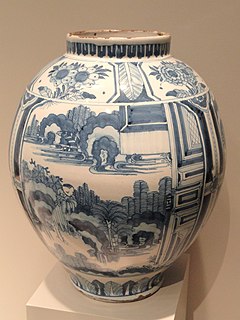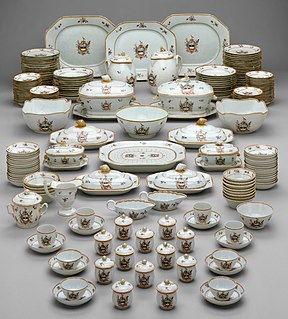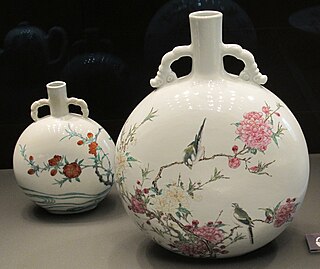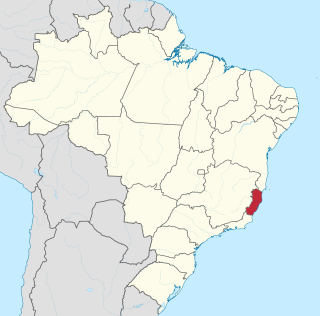
Delftware or Delft pottery, also known as Delft Blue, is a general term now used for Dutch tin-glazed earthenware, a form of faience. Most of it is blue and white pottery, and the city of Delft in the Netherlands was the major centre of production, but the term covers wares with other colours, and made elsewhere. It is also used for similar pottery, English delftware.

Porcelain is a ceramic material made by heating substances, generally including materials such as kaolinite, in a kiln to temperatures between 1,200 and 1,400 °C. The strength and translucence of porcelain, relative to other types of pottery, arises mainly from vitrification and formation of the mineral mullite within the body at these high temperatures. Though definitions vary, porcelain can be divided into three main categories: hard-paste, soft-paste, and bone china. The category that an object belongs to depends on the composition of the paste used to make the body of the porcelain object and the firing conditions.

Pedreira is a municipality in the state of São Paulo in Brazil. It is part of the Metropolitan Region of Campinas. The population is 48,463 in an area of 108.82 km². The elevation is 590 m. The town is located 138 km from the capital. It is called "Flor da Porcelana" because of its porcelain related commerce. Pedreira was founded in 1896. It is linearly distributed on Jaguari River banks. The name of the town comes from the name "Pedro", present in the most male members of the founder's family, Colonel João Pedro de Godoy Moreira. Pedreira offers as main attraction its large porcelain, glasses, wood crafts, aluminium, decoration pieces commerce, with shops especialized in tourist service.

Tableware is any dish or dishware used for setting a table, serving food, and dining. It includes cutlery, glassware, serving dishes, and other items for practical as well as decorative purposes. The quality, nature, variety and number of objects varies according to culture, religion, number of diners, cuisine and occasion. For example, Middle Eastern, Indian or Polynesian food culture and cuisine sometimes limits tableware to serving dishes, using bread or leaves as individual plates. Special occasions are usually reflected in higher quality tableware.

Chinese export porcelain includes a wide range of Chinese porcelain that was made (almost) exclusively for export to Europe and later to North America between the 16th and the 20th century. Whether wares made for non-Western markets are covered by the term depends on context. Chinese ceramics made mainly for export go back to the Tang dynasty if not earlier, though initially they may not be regarded as porcelain.

"Blue and white pottery" covers a wide range of white pottery and porcelain decorated under the glaze with a blue pigment, generally cobalt oxide. The decoration is commonly applied by hand, originally by brush painting, but nowadays by stencilling or by transfer-printing, though other methods of application have also been used. The cobalt pigment is one of the very few that can withstand the highest firing temperatures that are required, in particular for porcelain, which partly accounts for its long-lasting popularity. Historically, many other colours required overglaze decoration and then a second firing at a lower temperature to fix that.

Famille jaune, noire, rose, verte are terms used in the West to classify Chinese porcelain of the Qing dynasty by the dominant colour of its enamel palette. These wares were initially grouped under the French names of famille verte, and famille rose by Albert Jacquemart in 1862. The other terms famille jaune (yellow) and famille noire (black) may have been introduced later by dealers or collectors and they are generally considered subcategories of famille verte. Famille verte porcelain was produced mainly during the Kangxi era, while famille rose porcelain was popular in the 18th and 19th century. Much of the Chinese production was Jingdezhen porcelain, and a large proportion were made for export to the West, but some of the finest were made for the Imperial court.

Famille rose is a type of Chinese porcelain introduced in the 18th century and defined by the presence of pink colour overglaze enamel. It is a Western classification for Qing dynasty porcelain known in Chinese by various terms: fencai, ruancai, yangcai, and falangcai. The colour palette is thought to have been introduced in China during the reign of Kangxi (1654–1722) by Western Jesuits who worked at the palace, but perfected only in the Yongzheng era when the finest pieces were made.

Canton or Cantonese porcelain is the characteristic style of ceramic ware decorated in Guangzhou, the capital of Guangdong and the sole legal port for export of Chinese goods to Europe. As such, it was one of the major forms of exportware produced in China in the 18th and 20th centuries.

João Ubaldo Ribeiro was a Brazilian writer, journalist, screenwriter and professor. Several of his books and short stories have been turned into movies and TV series in Brazil. Ribeiro was a member of the Brazilian Academy of Letters, being elected in 1994. At the time of his death many considered him to be Brazil's greatest contemporary novelist.

Chinese ceramics show a continuous development since pre-dynastic times and are one of the most significant forms of Chinese art and ceramics globally. The first pottery was made during the Palaeolithic era. Chinese ceramics range from construction materials such as bricks and tiles, to hand-built pottery vessels fired in bonfires or kilns, to the sophisticated Chinese porcelain wares made for the imperial court and for export. Porcelain was a Chinese invention and is so identified with China that it is still called "china" in everyday English usage.

Jingdezhen porcelain is Chinese porcelain produced in or near Jingdezhen in Jiangxi province in southern China. Jingdezhen may have produced pottery as early as the sixth century CE, though it is named after the reign name of Emperor Zhenzong, in whose reign it became a major kiln site, around 1004. By the 14th century it had become the largest centre of production of Chinese porcelain, which it has remained, increasing its dominance in subsequent centuries. From the Ming period onwards, official kilns in Jingdezhen were controlled by the emperor, making imperial porcelain in large quantity for the court and the emperor to give as gifts.

The Ema Gordon Klabin Cultural Foundation is an art museum located in the city of São Paulo, Brazil. Officially established in 1978, it is a not-for-profit private institution, legally declared as an organization of federal public interest. It was created by the Brazilian collector and philanthropist Ema Gordon Klabin (1907–1994), with the purpose of preserving and displaying her art collection, as well as promoting cultural, artistic and scientific activities. The foundation is headquartered in Ema's former house in Jardins district, specially designed by architect Alfredo Ernesto Becker in the 1950s to hold her collection. The house is surrounded by a 4,000 square meters garden projected by Brazilian landscape architect Roberto Burle Marx.

Espírito Santo is a state in southeastern Brazil. Its capital is Vitória, and its largest city is Serra. With an extensive coastline, the state hosts some of the country's main ports, and its beaches are significant tourist attractions.
José Veiga, known as José J. Veiga, was a Brazilian writer. His writings are often classified within the magical realism genre, although he denied the label; his books deal with social and political criticism, with lyrical overtones.

From mid-2014 onward, Brazil experienced a severe economic crisis. The country's Gross Domestic Product (GDP) fell by 3.5% in 2015 and 3.3% in 2016, after which a small economic recovery began. That recovery continued until 2020, when the COVID-19 pandemic began to impact the economy again.
A Voz do Carnaval is a 1933 Brazilian short film documentary, directed by Adhemar Gonzaga and released by production company Cinédia. With no copies preserved, it is considered a lost film.

Companhia Cinematográfica Vera Cruz was an important Brazilian film studio founded in 1949 and closed in 1954. Located in São Bernardo do Campo, it was created by the industrialists Franco Zampari and Francisco Matarazzo Sobrinho. The company produced and coproduced more than 40 feature films, including O Cangaceiro, one of the most successful movies in Brazilian cinema's history.

The Casa-Museu Medeiros e Almeida is one of the most important Portuguese private decorative arts collections, gathered by the businessman, collector, and benefactor António Medeiros e Almeida (1895–1986).

The Macau Scientific and Cultural Centre Museum in Lisbon is Portugal's main museum of Chinese artefacts and artworks. Made to document Sino-Portuguese relations, the museum contains over 3,500 works of art including decorative artwork, costumes, a collection of opium-smoking paraphernalia and an important extensive collection of Chinese ceramics.





















